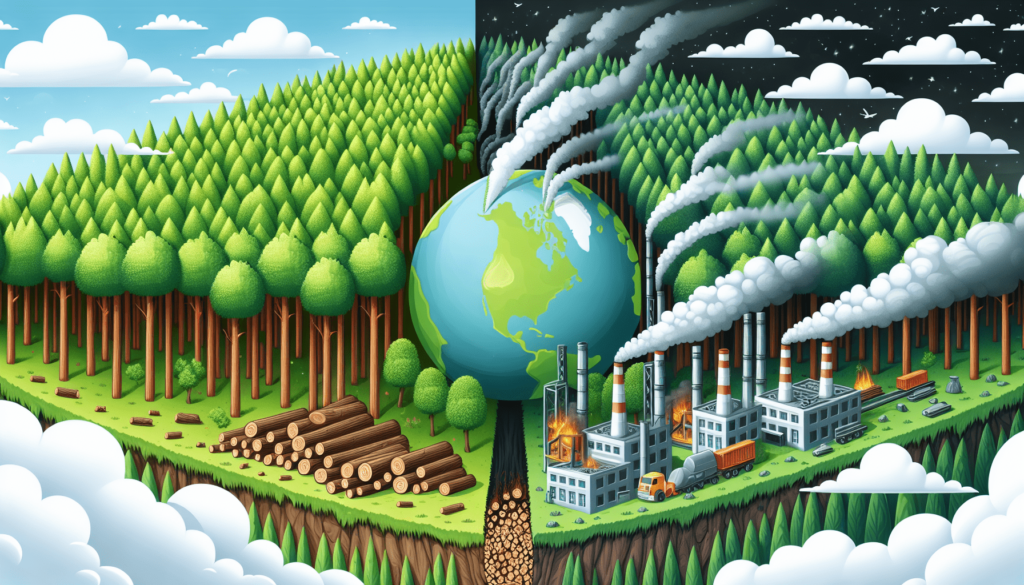Imagine a world where we no longer waste wood, where every single piece is utilized to its fullest potential. In this thought-provoking article, we examine the various ways in which our society unconsciously squanders this precious resource. From discarded furniture to inefficient construction practices, we delve into the reasons behind this wastefulness and explore innovative solutions to help us preserve and maximize the value of our beloved wooden treasures. Find out how we can collectively make a significant difference in reducing unnecessary wood waste and ultimately create a more sustainable future for our planet.

Excessive Logging
Deforestation for Agriculture
One major way we are wasting wood is through deforestation for agricultural purposes. As the demand for food continues to rise, forests are cleared to make way for large-scale agriculture. This process involves cutting down vast areas of trees, leading to the destruction of diverse ecosystems and the displacement of numerous species. Not only does this result in the loss of valuable habitats, but also contributes to soil erosion and degradation. Additionally, the carbon dioxide stored in trees is released into the atmosphere, exacerbating climate change.
Clear-cutting for Timber
Another significant contributor to wood waste is clear-cutting for timber. Clear-cutting involves cutting down all the trees in a specific area rather than selectively harvesting only the mature or diseased ones. This method is often employed due to its efficiency in maximizing timber yields. However, the detrimental environmental consequences are undeniable. Clear-cutting not only leads to the destruction of forests and the loss of biodiversity, but it also disrupts natural water cycles, increases the risk of wildfires, and reduces the ability of forests to capture and store carbon.
Illegal Logging
Illegal logging is a pervasive issue that further exacerbates wood waste. It involves the harvesting, processing, and trade of timber in violation of national laws and regulations. Illegal logging contributes to deforestation, habitat destruction, and biodiversity loss, undermining efforts to promote sustainable forest management. It often occurs in regions with weak governance and inadequate law enforcement, fueling corruption and causing socio-economic instability. This not only affects the environment but also the livelihoods of local communities who rely on forests for their survival.
Inefficient Manufacturing Processes
Low Yield from Trees
One aspect of wood waste in manufacturing processes is the low yield achieved from trees. In traditional sawmilling, many parts of the tree, such as branches, knots, and smaller-diameter logs, are considered waste and discarded. This results in a significant amount of wood being lost and underutilized. Furthermore, the inefficient utilization of the timber resource leads to a higher demand for more trees to meet market demands, aggravating deforestation and the depletion of forests.
Waste during Sawing and Milling
During the sawing and milling process, a considerable amount of wood waste is generated due to inefficient cutting techniques and suboptimal equipment. These wasteful practices result in irregular shapes and sizes of lumber, reducing their usability and market value. The discarded wood waste from sawing and milling can be substantial and often ends up in landfills, contributing to environmental pollution and the squandering of a valuable resource.
Inadequate Use of By-products
The inadequate utilization of by-products in the wood industry is another form of wastage. By-products such as sawdust, bark, and wood chips are often considered waste and disposed of, even though they can have various applications. Sawdust, for example, can be used for animal bedding, mulching, or converted into wood pellets for heating. The underutilization of these by-products not only results in a missed opportunity for additional revenue but also leads to unnecessary waste accumulation and environmental burdens.
Unsustainable Construction Practices
Overuse of Lumber in Building
Unsustainable construction practices contribute significantly to wood waste. One common issue is the overuse of lumber in building projects. Many builders tend to use more wood than necessary, either due to inefficient design or a lack of consideration for alternative building materials. This not only depletes forests but also leads to higher construction costs and increased environmental impacts. By adopting sustainable construction practices and utilizing other materials, such as steel or concrete, we can reduce the excessive use of wood and preserve this valuable resource.
Lack of Recycling or Reusing Wood
Another aspect of wood waste in construction is the lack of recycling or reusing wood materials. Instead of disposing of wood products after their intended use, they often end up in landfills. By implementing effective recycling programs and promoting the reuse of wood materials, we can reduce the demand for new wood and contribute to a more sustainable construction industry. Reclaimed wood can be used in various applications, such as flooring, furniture, or accent pieces, allowing us to give new life to old wood and reduce the strain on natural resources.
Poor Design and Disposal Practices
Poor design choices and inadequate disposal practices also contribute to the waste of wood in construction. Many buildings are constructed with materials that have a short lifespan, resulting in frequent replacements and unnecessary waste generation. Additionally, improper disposal of wood waste from construction sites can lead to environmental pollution and damage. By improving design standards and implementing proper disposal procedures, we can minimize the negative impact of construction on the environment and promote the efficient use of wood resources.
Excessive Packaging and Shipping
Packaging Material Made from Wood
One way in which we waste wood is through the excessive use of wood-based packaging material. Cardboard boxes, pallets, and wooden crates are commonly used for shipping and storage purposes. While wood is a renewable resource, its excessive use in packaging contributes to deforestation and the depletion of forests. Finding alternative packaging materials that are more sustainable, such as recycled or biodegradable options, can minimize the environmental impact and reduce wood waste in the packaging industry.
Unnecessary Use of Wooden Pallets
Wooden pallets are frequently used for shipping goods worldwide. However, many of these pallets are discarded after a single use, contributing to significant wood waste. By promoting the reuse or recycling of wooden pallets, we can reduce the demand for new ones and conserve valuable wood resources. Initiatives such as pallet pooling, where pallets are shared among multiple companies, can help minimize waste and optimize the use of existing pallets.
Long-distance Shipping of Wood Products
The transportation of wood products over long distances also contributes to wood waste. Shipping products globally requires significant energy consumption and contributes to greenhouse gas emissions. By promoting local sourcing and reducing the reliance on long-distance shipping, we can minimize the environmental impact associated with the transportation of wood products. Additionally, encouraging sustainable forestry practices in different regions can reduce the need for importing wood from distant locations, further minimizing waste and environmental degradation.

Disposable Wood Products
Single-use Packaging
Disposable wood products, such as single-use packaging made from wood, contribute to unnecessary waste. Items like wooden cutlery, plates, and coffee stirrers are frequently used for short periods and then discarded. These products often end up in landfills, where they take a long time to decompose. By promoting more sustainable alternatives, such as biodegradable or reusable materials, we can reduce the waste generated from disposable wood products and minimize the strain on our natural resources.
Disposable Cutlery and Utensils
As with packaging, disposable cutlery and utensils made from wood are convenient but contribute to significant waste. The production and disposal of these single-use products result in the unnecessary depletion of forests and increased environmental pollution. By adopting more sustainable practices, such as using biodegradable or compostable alternatives, we can avoid the wasteful use of wood and promote a more environmentally friendly approach to food service.
Disposable Furniture and Home Decor
The use of disposable wooden furniture and home decor items also contributes to wood waste. Many cheaper furniture options are designed to have a short lifespan and are meant to be discarded and replaced frequently. This trend not only contributes to deforestation but also results in the squandering of valuable resources. By investing in durable, high-quality furniture and promoting the reuse or repurposing of wood products, we can reduce waste and create a more sustainable approach to furnishing our homes.
Unawareness and Lack of Education
Limited Understanding of Sustainable Wood Use
A significant factor contributing to wood waste is the limited understanding of sustainable wood use among individuals and industries. Many people are unaware of the environmental implications of their wood consumption choices and the need to prioritize sustainable alternatives. By increasing awareness and educating the public about the importance of sustainable forest management and responsible wood consumption, we can encourage more informed decision-making and promote a culture of sustainability.
Lack of Awareness Regarding Alternatives to Wood
In addition to limited understanding, there is often a lack of awareness regarding alternatives to wood products. Many individuals and industries default to using wood without considering more sustainable options. By highlighting the availability and benefits of alternative materials, such as bamboo, recycled plastic, or metal, we can diversify product choices and reduce the demand for wood, resulting in less waste and improved environmental outcomes.
Insufficient Knowledge of Proper Wood Disposal
Improper wood disposal practices are prevalent due to insufficient knowledge of proper disposal methods. Many individuals and businesses are unsure of how to dispose of wood waste responsibly, leading to improper waste management and environmental pollution. By providing accessible information and resources on proper wood disposal, such as recycling programs or wood waste management facilities, we can ensure that wood is disposed of in an environmentally responsible manner and minimize waste accumulation.
Wood Waste in Household and Commercial Sectors
Discarding Furniture and Home Renovation Waste
Wood waste in the household and commercial sectors often occurs during renovations and the disposal of furniture. When furniture or wood-based materials are no longer needed, they are frequently discarded, contributing to significant waste. By promoting furniture repair, recycling, and donation programs, we can extend the lifespan of wood products and reduce the amount of waste sent to landfills. Additionally, encouraging sustainable design practices that prioritize durability and adaptability can minimize the need for frequent renovations and further reduce wood waste.
Excessive Printing and Paper Waste
The excessive use of paper derived from wood is a prevalent issue in both household and commercial sectors. The production of paper products, such as notebooks, magazines, and packaging, requires a substantial amount of wood fiber. Much of this paper is used once and then discarded, leading to significant waste. By promoting digital alternatives, encouraging responsible printing practices, and implementing recycling programs, we can reduce the demand for new wood-based paper and minimize paper waste.
Wasted Wood in Manufacturing Industries
Wood waste is also prevalent in manufacturing industries, where inefficient practices and suboptimal material utilization contribute to significant waste generation. From furniture production to woodworking factories, the lack of efficient manufacturing processes results in the underutilization or disposal of valuable wood resources. By investing in advanced machinery, optimizing production techniques, and fostering a culture of waste reduction, we can minimize wood waste and maximize the value obtained from each tree harvested.
Losses in Supply Chain and Storage
Wood Decay and Deterioration
Wood decay and deterioration during storage and transportation contribute to significant losses in the wood supply chain. Improper handling and storage conditions result in moisture accumulation and fungal growth, rendering the wood unfit for use. By implementing proper storage practices, such as controlling humidity levels and protecting wood from exposure to the elements, we can minimize wood decay and ensure the optimal utilization of this valuable resource.
Inefficient Wood Preservation Methods
Inadequate wood preservation methods also contribute to losses in the supply chain. Without proper treatment, wood is susceptible to decay, pest infestation, and other forms of damage. By investing in effective wood preservation techniques, such as pressure treatment, heat treatment, or chemical treatment, we can extend the lifespan of wood products and minimize waste throughout the supply chain. Additionally, promoting the use of sustainably sourced and naturally durable wood species can further reduce the need for extensive preservation methods.
Storage and Distribution Losses
Storage and distribution losses occur when wood products are mishandled or inadequately protected during transportation. Physical damage, exposure to moisture, or incorrect stacking can lead to substantial losses in the supply chain. By implementing quality control measures, training personnel in proper handling techniques, and using appropriate packaging and protection methods, we can reduce losses and ensure the efficient utilization of wood resources throughout the supply chain.
Inadequate Reclamation and Recyclability
Lack of Wood Recycling Infrastructure
One significant challenge in reducing wood waste is the lack of adequate wood recycling infrastructure. While wood is a recyclable material, it often ends up in landfills due to the limited availability of recycling facilities. By investing in the development of wood recycling infrastructure, including collection centers and processing facilities, we can create a circular economy for wood products, reducing waste and promoting the sustainable use of this valuable resource.
Challenges in Recycling Composite Wood Products
Composite wood products, such as plywood or particleboard, pose specific challenges in terms of recycling. These products are typically made by combining wood fibers or particles with adhesives, making the separation and recycling of wood more complex. By investing in research and technology to improve the recyclability of composite wood products, we can overcome these challenges and reduce the waste generated from these commonly used materials.
Insufficient Efforts in Salvaging and Reclaiming Wood
Salvaging and reclaiming wood from demolished buildings or other sources is an effective way to reduce waste and extend the lifespan of this valuable resource. However, insufficient efforts are often made to salvage and reclaim wood, resulting in unnecessary waste and missed opportunities. By promoting the salvage and reuse of wood materials through initiatives such as architectural salvage programs or reclaimed wood markets, we can significantly reduce wood waste and preserve the embodied energy and history within each piece of reclaimed wood.
Impact of Wood Waste on the Environment
Deforestation and Loss of Biodiversity
The impact of wood waste on the environment cannot be overstated. The excessive logging and inefficient utilization of wood resources contribute to deforestation, resulting in the loss of critical habitats and the extinction of numerous species. Deforestation disrupts ecosystems, affects water cycles, and reduces the capacity of forests to absorb carbon dioxide. By minimizing wood waste, promoting sustainable forest management, and utilizing wood more efficiently, we can mitigate the detrimental environmental effects associated with deforestation and protect biodiversity.
Greenhouse Gas Emissions and Climate Change
Wood waste, especially when left to decompose in landfills, contributes to greenhouse gas emissions. As wood decomposes, it releases methane, a potent greenhouse gas that significantly contributes to climate change. Additionally, the inefficient utilization of wood resources and the subsequent need for more logging result in higher carbon dioxide emissions. By reducing wood waste, implementing proper disposal methods, and maximizing the utilization of each tree harvested, we can minimize greenhouse gas emissions and combat climate change.
Land and Water Pollution
Wood waste, particularly in the form of improper disposal or ineffective manufacturing processes, contributes to land and water pollution. When wood waste is improperly disposed of or ends up in landfills, it can release harmful chemicals, pollutants, and toxins into the environment. Additionally, the improper treatment or storage of wood products can lead to chemical runoff, contaminating soil and water sources. By adopting responsible waste management practices, implementing effective treatment methods, and promoting sustainable manufacturing processes, we can minimize pollution and protect our precious land and water resources.
In conclusion, the waste of wood resources occurs through various means, including excessive logging, inefficient manufacturing processes, unsustainable construction practices, excessive packaging and shipping, disposable wood products, lack of awareness and education, wood waste in households and commercial sectors, losses in the supply chain and storage, inadequate reclamation and recyclability, and the overall impact on the environment. By addressing these issues through sustainable practices, responsible consumption choices, and implementing efficient waste management strategies, we can minimize wood waste, conserve forests, and ensure the long-term sustainability of this valuable natural resource.

Hi, I’m James Gheen, the creator behindWoodRebirth.com. As someone passionate about sustainability and environmental stewardship, I created this pioneering online platform to change how we approach wood waste and pallet disposal. Through detailed recycling and disposal guides, creative DIY projects, and upcycling inspirations, I aim to inspire individuals and businesses to adopt eco-friendly practices in their wood waste management. At WoodRebirth.com, we foster a vibrant community focused on education and engagement, encouraging the sharing of ideas and success stories. Join me in our mission to give wood waste a new lease on life, making a tangible impact on our environment, one pallet at a time.

